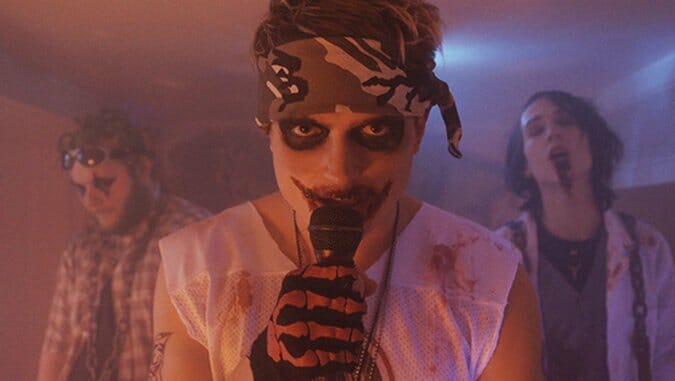
Michael Bilandic’s new film Hellaware revolves around Nate (Keith Poulson), a wannabe photographer whose talent is undercut by his rich kid malaise and distaste for what he derides as the “incestuous” nature of the art world. Convinced that the only way he can overhaul his lackluster life is through professional acclaim, he sets off for Delaware, bent on photographing a teenage rap-rock group called Young Torture Killaz. Bilandic’s lucky: if he weren’t so obviously born to direct a fish-out-of-water story, Hellaware would feel pretty tired.
Instead, it’s a Faustian parable about the exploitative nature of art and the lengths to which people will go for success. Bilandic illustrates New York’s decadence and isolation from the rest of the country with ease, folding that distinction of class even further into the whole world of YTK’s ICP-ish Dark Carnival, so that when Nate and friend-with-benefits Bernadette (Sophia Takal) first arrive at a Young Torture Killaz concert, the disparity between the Manhattanites and the Delawareans is painful. Urban vs. rural, rich vs. lower middle class, rap vs. rock: it’s all pretty obvious until one thinks, “What kind of people would actually go to an ICP show?”
Their clothes are different, the way they carry themselves is different, the way they speak is different; everything is strange and foreign for Nate and Bernadette. Bilandic lends both the Killaz and the New Yorkers such starkly strong points of view that the moment of their first contact transcends the film’s originally obvious satire and sings with something palpably deeper about region and class conflict.
So Nate and Bernadette slum it, sampling the “exotic” culture of the hinterlands, knowing they can return to the warm embrace of the Imperial Capital whenever the whim grips them. The Killaz, of course, can’t. Their life won’t get better than a sparsely attended concert in the basement of someone’s parents’ house. When Nick tells YTK frontman Rusty that he has music contacts in the City, Rusty’s face lights up. Rusty, alone among the group, seems to know that there’s something better out there than rural Delaware.
Strangely though, Bilandic doesn’t seem capable of or even much interested in showing what happens after the initial shock of two worlds colliding goes away, because he does a beautiful job setting up two conflicting viewpoints but ultimately carries that conflict nowhere. Even though the second and third acts are bogged down with plot, Bilandic can’t seem to keep the story from evaporating. As Nick’s photos garner more and more attention, Nate and Bernadette’s relationship starts to collapse, Nate is chosen to participate in a prestigious art show, Nate starts to act like a jerk…something something something…and phhffffft: whatever, we get it.
We got it from the beginning. From the moment Rusty’s white trash parents opened the door to their double wide and Nick starts taking snap shots, we understood where this story was going. Keith Poulson’s Nate is specific and likable, despite his flaws. Sophia Takal’s performance is charming without being cloying. Brent Butler’s Rusty manages a neat balance between lonely, artistic, enigmatic and ambitious. The movie seesaws between absurdism and realism in a way that lends the film a sense of levity beyond its obligatory sad-sack nature. But all of the movie’s build-up ultimately amounts to a zero sum. Perhaps Bilandic’s focus on mocking the art world keeps him from fitfully developing the relationships between such different characters; perhaps Bilandic could have given such a wealth of interesting characters something interesting to do.
Director: Michael M. Bilandic
Writer: Michael M. Bilandic
Starring: Keith Poulson, Sophia Takal, Brent Butler
Release Date: September 26, 2014